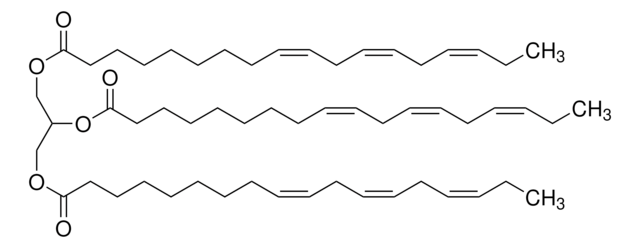Kluczowe dokumenty
Y0001113
Triolein
European Pharmacopoeia (EP) Reference Standard
Synonim(y):
Glyceryl trioleate, (9Z)9-Octadecenoic acid 1,2,3-propanetriyl ester, 1,2,3-Tri(cis-9-octadecenoyl)glycerol, Glycerol trioleate, Glycerol triolein, Oleic acid triglyceride, Oleic triglyceride, TG(18:1(9Z)/18:1(9Z)/18:1(9Z)), Triolein
About This Item
Polecane produkty
klasa czystości
pharmaceutical primary standard
rodzina API
triolein
producent / nazwa handlowa
EDQM
bp
235-240 °C/18 mmHg (lit.)
gęstość
0.91 g/mL (lit.)
Zastosowanie
pharmaceutical (small molecule)
Format
neat
temp. przechowywania
−20°C
ciąg SMILES
[H]C(COC(CCCCCCC/C=C\CCCCCCCC)=O)(OC(CCCCCCC/C=C\CCCCCCCC)=O)COC(CCCCCCC/C=C\CCCCCCCC)=O
InChI
1S/C57H104O6/c1-4-7-10-13-16-19-22-25-28-31-34-37-40-43-46-49-55(58)61-52-54(63-57(60)51-48-45-42-39-36-33-30-27-24-21-18-15-12-9-6-3)53-62-56(59)50-47-44-41-38-35-32-29-26-23-20-17-14-11-8-5-2/h25-30,54H,4-24,31-53H2,1-3H3/b28-25-,29-26-,30-27-
Klucz InChI
PHYFQTYBJUILEZ-IUPFWZBJSA-N
Szukasz podobnych produktów? Odwiedź Przewodnik dotyczący porównywania produktów
Opis ogólny
Zastosowanie
Opakowanie
Inne uwagi
Kod klasy składowania
10 - Combustible liquids
Klasa zagrożenia wodnego (WGK)
awg
Temperatura zapłonu (°F)
626.0 °F - closed cup
Temperatura zapłonu (°C)
330.0 °C - closed cup
Wybierz jedną z najnowszych wersji:
Certyfikaty analizy (CoA)
It looks like we've run into a problem, but you can still download Certificates of Analysis from our Dokumenty section.
Proszę o kontakt, jeśli potrzebna jest pomoc Obsługa Klienta
Masz już ten produkt?
Dokumenty związane z niedawno zakupionymi produktami zostały zamieszczone w Bibliotece dokumentów.
Klienci oglądali również te produkty
Nasz zespół naukowców ma doświadczenie we wszystkich obszarach badań, w tym w naukach przyrodniczych, materiałoznawstwie, syntezie chemicznej, chromatografii, analityce i wielu innych dziedzinach.
Skontaktuj się z zespołem ds. pomocy technicznej









